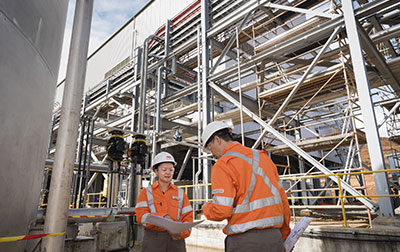Operational readiness: The unsung hero of project success

To achieve this, all operational elements must be in place before handover. This includes reliable equipment, capable personnel, compliant and efficient processes, and a mindset focused on safety and continuous improvement. OR ensures that when the plant manager receives the keys, they aren’t inheriting risk—they’re inheriting opportunity.
The distinction between OR and project completion
A common misconception is that if a project is delivered on time and on budget, it is successful. But true success is measured by achieving and sustaining the business case. OR aligns future operations with an organization’s strategic intent and long-term goals.
Traditionally, projects are seen as a collaboration between construction and operations. But this view misses a crucial element. A high-performing transition requires three interdependent but distinct components: construction, operations, and the transitional OR team. The latter facilitates a safe, efficient ramp-up and strives to reduce risk at both ends of the value chain.
This distinction matters because capital projects are funded with the expectation of financial return. Construction focuses on minimizing capital expenditure (CAPEX); operations on managing operational expenditures (OPEX). Neither is inherently incentivized to ensure the business case is delivered or to work toward that end. OR provides a structured framework, integrated planning, clear governance, and specialized capability to align both sides and deliver the business case.
Understanding the OR value stream
OR delivers value through three interconnected stages:
- ‘Value add’ (concept and pre-FEED):
OR begins early by shaping an asset to be fit-for-purpose. This includes aligning project decisions with strategic business outcomes and ensuring design choices support operability and maintainability. Getting this right avoids costly rework, supports construction by clarifying requirements, and reduces future OPEX by delivering an operation designed for real-world performance. It also ensures early alignment between project delivery and operational intent. Crucially, it includes ensuring project outputs such as vendor documentation, equipment data, and design information are delivered on schedule and in a usable format.
- ‘Value protect’ (execution phase):
In this phase, OR protects against misalignment by validating systems, refining operating strategies, and embedding integrated processes. OR spans all functions: operations, maintenance, human resources, finance, supply chain, health, safety, environment and community, legal, information and operational technology systems, and engineering. It ensures these elements are not siloed but coordinated with transparency and purpose. This approach is not about additional cost but preventing performance loss and enabling a controlled, efficient ramp-up.
- ‘Value realization’ (start-up, ramp-up, operations):
Value realization is the outcome of well-executed value-add and value-protect activities. It occurs when readiness turns into performance and is characterized by safe ramp-up, cultural alignment, and operational excellence. Investors, executives, and especially lenders want assurance that the operation is positioned to deliver value from day one, and scaled to full potential quickly and sustainably. Lenders want confidence that their investment will be protected through disciplined, proven operational preparation.
The early bird gets the value
Mature organizations know OR must be embedded early, during concept development and initial design. They prioritize operability in layout and equipment selection, ensure OR requirements are embedded into project scope and clearly reflected in contracts (especially vendor and engineering, procurement, and construction contracts), and define handover expectations well before construction ramps up. They align project goals with operational outcomes from the start. A robust contract structure ensures OR-related deliverables are scheduled and tracked, making timely readiness execution possible.
Organizations that engage OR too late, or fail to execute effectively, do so at their own peril. Often, this is due to short-term cost cutting or market-driven uncertainty. Deferring OR is like building a plant but not hiring the operators or installing control systems. Instead of delivering value, you’re scrambling to stabilize.
Discipline: The backbone of OR execution
Operational readiness is only effective if executed with discipline. A strong OR plan is a blueprint for value, not a loose checklist. Under project pressure, it’s discipline that protects outcomes.
Take a real-world example: a multibillion-dollar manufacturing facility that embedded OR from the outset, led by experienced practitioners. Responsibilities were clear. Tools like Hatch’s proprietary digital management system, Ready, ensured deliverable alignment by acting as a single source of truth, supporting change management, and enabling exception-based reporting to identify areas of concern early. Hatch’s METRO milestone mapping system provided integration visibility across stakeholders—construction, vendors, and operations—allowing risks to be identified and managed before they became problems.
This worked because the OR team had been experienced, were using the right systems, and knew the common pitfalls. They could see the gaps before others noticed them. They weren’t just facilitators, but integrators. As a result, nameplate capacity exceeded by 20% within six months.
OR is the enabler of value
Operational readiness is a strategic enabler. Done well, it increases productivity, profitability, and confidence. It builds culture, strengthens systems, and lays the foundation for continuous improvement. It’s the difference between commissioning an asset and launching a successful business.
What organizations need to do:
- Value add – Embed OR into project strategy early. Align design with operational goals. Build in clarity, not complexity. Create shared ownership between project and operations. Get this right, and you de-risk both CAPEX and OPEX exposure.
- Value protect – Execute using experienced, cross-functional teams. Align systems, validate processes, and manage integration. Use transparent reporting and a single source of truth to drive consistency and accountability.
- Value realization – Sustain the capability you’ve built. Monitor for integration risks, scope creep, and shifting priorities. Ensure continuous improvement stays linked to the original business case.
When operations begin, it’s not the construction schedule or budget that will be judged. It’s whether the business delivers what it promised. Operational readiness ensures you don’t just reach that point but exceed it. Contact Hatch to learn how our highly experienced OR professionals can develop and implement a disciplined operational readiness strategy to ensure your projects exceed delivery expectations.
